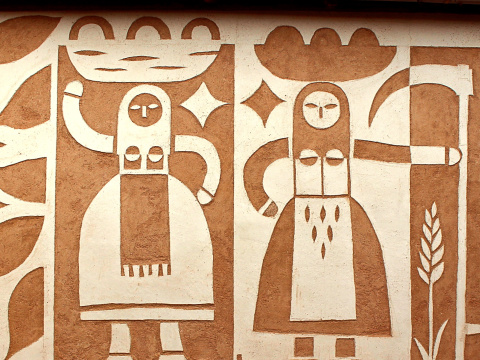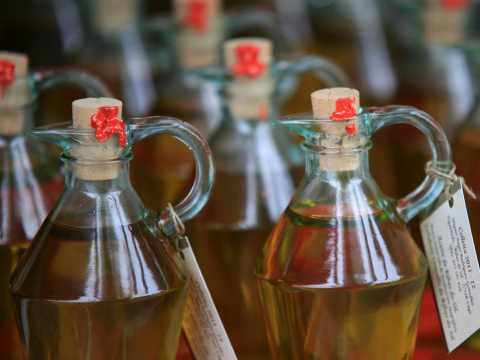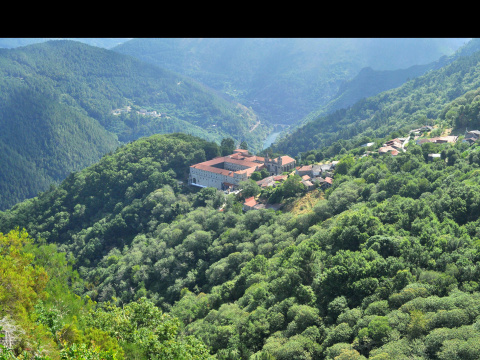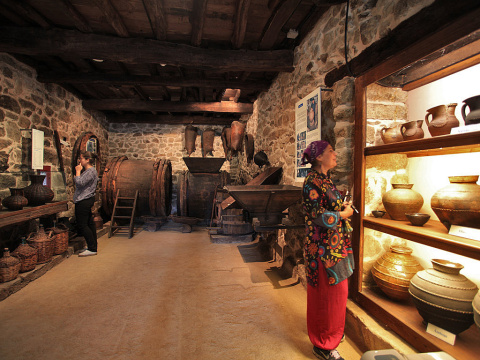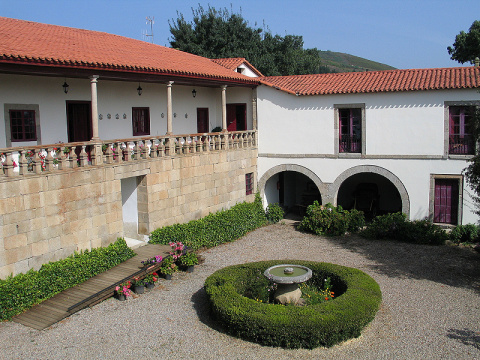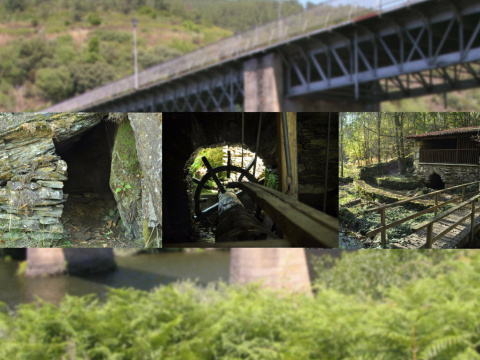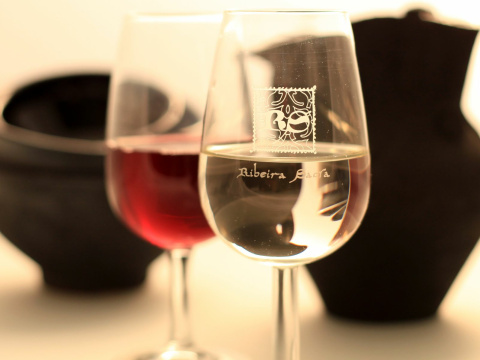European Year of Cultural Heritage
The European Union has declared 2018 as the European Year of Cultural Heritage. For that reason, from the CTRS we do not want to finalize it without making known the most representative of our heritage. Every day of the month we will update this news and our profile in Social Networks showing the essence of Ribeira Sacra.
A touch of color in Ribeira Sacra
In 2015, we started a project of "muralization" of "feísmo"* in the 21 municipalities of Ribeira Sacra, recovering walls, buildings and degraded architectural elements through urban art interventions. Through one of the most contemporary expressions of art, the mural/graffiti, decadent spaces close to the most important resources have become open-air pieces of art.
In all of them we can see represented our intangible and tangible heritage: legends, trades, parties, ... of Ribeira Sacra.
[DOWNLOAD BROCHURE A TOUCH OF COLOR IN RS]
* Term to define in Galicia the substandard housing, constructions, infrastructures or human works with a high degree of mediocrity that degrade in any way the environment.
Traditional boats
For the harvesting of the grape, for fishing, to cross from one shore to another, for a walk, dornas, etc. Numerous types of traditional boats that we could find cruising our rives until a few decades ago. until a few decades ago. Nowadays, these boats have fallen into disuse, although we can see many of these pieces in the Ecomuseo de Arxeriz, which has one of the most important exhibitions of riverboats in Spain.
In summer, it is possible to rent traditional boats in Monforte de Lemos, along the river Cabe.
Dry stone walling
Last November, UNESCO declared the Dry Stone Walling as Intangible Cultural Heritage of Humanity. Eight countries on the list and nine Spanish communities; among them, Galicia. There are abundant and significant examples of dry stone structures in the whole Galician territory, especially in Ribeira Sacra, where we can find this type of constructions in elements such as alvarizas (circular structure to close a set of beehives), riverbank wineries, sequeiros (construction to store and dry chestnuts), walls to close plots, etc.
Sgraffito in Ribeira Sacra
During the year 2017, the Ribeira Sacra Tourism Consortium launched a comprehensive plan for disseminating, restoring and raising awareness of this unique heritage, which is both so characteristic of the Ribeira Sacra and so unknown. Several different actions focused efforts on studying and researching this technique, on restoring unique buildings, on experimenting with new wall decoration using lime and on raising awareness amongst the local population by means of workshops and information days (detailed information here).
The plan does not end here, because the Ribeira Sacra Tourism Consortium organizes guided tours within its programs of activities over the year.
The xacias and fish men
Acording to the legend, the lands of Chouzán, near Cabo do Mundo, there lived mythical creatures named xacias and xacios (Galician name); half human half fish, related without a doubt with the European culture of the Irish selkis, maritime sirens, and of the xanas de agua doce of Asturias. They often left the waters of the river Miño to fall in love with the boatmen and if they returned, they were not well received by the rest of the xacios.
Street trades
Knife-grinders and barquilleros are the most representative and well-known street trades in Ribeira Sacra. Both went to the big capitals in search of work, becoming recognized and iconic trades throughout Spain. There are many peculiarities that accompany these jobs, such as the knife-grinders own language (known as barallete) and the particular whistle that warns of his arrival; or the great importance of the barquilleros in his native town (Parada de Sil), giving name to one of the most famous viewpoints of Ribeira Sacra: Balcones de Madrid.
Wine culture in Ribeira Sacra
The wine, without a doubt, is one of the cultural and identity references of Ribeira Sacra; we can not understand our territory or the character of our people without this element. Learn about the history of wine in Ribeira Sacra by clicking here.
Carnival in Ribeira Sacra: the Entroido Ribeirao (Riverbank Carnival in Galician) and the Bear of Salcedo
The volantes (character of this carnival) with their puchos (hats with colored ribbons) in the Entroido Ribeirao (Chantada) and the bear in the Carnival of Salcedo (A Pobra do Brollón) are the protagonists of these ancestral celebrations. In the past, this event was celebrated to mark the end of winter and the beginning of the agricultural cycle, auguring fertility for good crops. Today, the tradition is still alive and they have become a real spectacle for visitors.
Pottery in Ribeira Sacra
Few traditional potteries are still active in Galicia. In Ribeira Sacra we can boast of having several craft centers in operation. Although with different elaboration and finishing process, these are highly appreciated ceramics throughout the territory in terms of quality and adaptation to the new uses of society. Nowadays, we can visit his workshops and museum spaces in Rectoral de Gundivós, Figulus and Museo-Taller Alfarería Niñodaguia.
Fachas or fachós
The fachas or fachós (torches) are elements formed by vegetal material and elaborated by the neighbors during weeks or months to be burned finally in a festive act that attracts numerous visitors. In many of these celebrations its origin can not be determined with certainty, although it is believed that they are traditions inherited from our ancestors the Celts, who through this rite would be grateful for the good harvests.
Today, 3 of these magical and unique celebrations are preserved in Ribeira Sacra: Queima das Fachas de Castelo (September 7, Taboada), Folión das Fachas de Vilelos (end of September, O Saviñao) and the Festa dos Fachós (January 19, Castro Caldelas).
Sábado Longo (Xunqueira de Espadanedo)
It is an original celebration in which on the eve of Easter Sunday the town's unmarried boys gather at night to steal the carts from the neighbors to take them to the church. They decorate the carts and place them face to face. The next day, people who go to the mass must go under. A tradition that still survives among the inhabitants of Xunqueira de Espadanedo.
Caldo de ósos (bones soup) (Taboada)
Generation after generation, the recipe of soup bones has been transmitted, a unique dish and typical of Taboada. In the past, it was elaborated in pig slaughter and nowadays, it can also be tasted in the local restaurants of the area. As it could not be otherwise, the neighbors exalt this delicacy with the celebration of the "Festa do Caldo de Ósos" (bones soup Festival) (information about 2018 edition).
Know more about Ribeira Sacra cuisine here.
Amandi Wine Fair (Sober)
Declared as Galician Festival of Touristic Interest since 2000, the Amandi Wine Fair is one of the most famous fairs of Ribeira Sacra. Each year, the winemakers present their wines to us on this festival where wine, gastronomy, crafts and music go hand in hand.
With a long tradition, other fairs also stand out: Chantada Wine Fair, Pantón Wine Fair, Vilachá Wine Fair (A Pobra do Brollóm) or Quiroga Wine Fair (schedule here).
Church of Santa María de Torbeo (Ribas de Sil)
Santa María de Torbeo is one of the most unknown Romanesque churches of Ribeira Sacra. Inside it Inside it keeps a jewel, a baptismal font of the 12th century, one of the few examples of immersion piles kept in Galicia.
Montefurado tunnel (Quiroga)
The Romans also left their legacy in Ribeira Sacra and, perhaps, one of its greatest exponents is found in the Montefurado tunnel; a large hole dug in the mountain that diverted the course of the river Sil, thus facilitating the task of extracting gold. Click here to know its current status.
Camino de Santiago, on its way through Portomarín
The town of Portomarín has been since the Middle Ages linked to the pilgrims who travelled to Santiago de Compostela by the French Way. This town also stands out for its relocation due to the construction of the Belesar reservoir in the 60s. The town was built again uphill, while important monuments such as pazos (Galician stately homes) or the church of San Xoan (or San Nicolás) were moved stone by stone to the new site .
Church of San Facundo de Ribas de Miño (Paradela)
It was built in the 12th century to accommodate pilgrims who travelled to Santiago de Compostela by the French Way, after the demolition by order of Doña Urraca of the bridge that crossed the Miño in Portomarín. It stands out, in addition, for being considered as the first manifestation of Gothic in the Iberian Peninsula and one of the first in Europe. Discover more about this temple here.
Teimende Chocolate House-Museum of Teimende (Parada de Sil)
The Teimende chocolate museum is the first and only museum in Galicia dedicated to this product. It was created in 2015 with the aim of safeguarding the chocolate activity of the town, a reference point in the region. The rooms of the museum take a tour of the history of chocolate, collect information on how it reached Ribeira Sacra, how it was made and the machinery used and finally, the difficult process for its distribution.
Monastery of Bernardas (Pantón)
The monastery of San Salvador de Ferreira, commonly known as monastery of Bernardas, is the only one in Ribeira Sacra that maintains religious life nowadays. It is currently inhabited by a female community and it is possible to visit the building. You can not leave without tasting the delicious pastries that they make themselves.
Church of Santo Estevo de Ribas de Miño (O Saviñao)
Challenging the terrain, Santo Estevo de Ribas de Miño rises on a steep slope with a privileged view over the river Miño. This building stands out for many of its architectural elements, which refer us to the works of Maestro Mateo (important artist of the last stage of construction of the Romanesque cathedral of Santiago de Compostela and author of the Pórtico de la Gloria) (more information) .
Monastery of Santo Estevo de Ribas de Sil (Nogueira de Ramuín)
The monastery of Santo Estevo de Ribas de Sil is one of the most prominent and spectacular of the rich monumental heritage of Galicia. Nowadays, it is turned into a National Parador of Tourism (accommodation), although the great majority of its dependencies can be visited. Learn about the history of one of the Ribeira Sacra jewels here.
Monastery of Santa María de Montederramo
The meaning of the name Ribeira Sacra is still a discussion among historians, although without a doubt, what they do coincide in is the appearance of the term for the first time; in 1124, Mrs Teresa de Portugal gave to the abbot called Arnaldo and the Benedictine monks who were with him a place called Rivoira Sacrata (or Roboira Sacrata) to found a monastery, located in Seoane Vello. Later, the order would be moved to the current monastery of Santa María de Montederramo.
Old town of Monforte de Lemos
The School of Nuestra Señora La Antigua (also known as "Galician Escorial"), the monument colletction of San Vicente del Pino, the Jewish quarter, the roman bridge or important museums such as the Galician Railway Museum or the Ribeira Sacra Wine Centre are some of the surprises that Monforte de Lemos keeps in its old town. Monforte de Lemos is the capital of Ribeira Sacra and the only city that we will find in the destination. Learn about the history of the city here.
Monastery of San Pedro de Rocas (Esgos)
If anyone knew the magic and spirituality of this land were, without a doubt, the monks. Numerous communities settled in search of the longed for peace and retirement. It all started here, in San Pedro de Rocas. It is considered the oldest Christian building in Galicia and one oldest in Spain (more information here).
Folión de Carros (Chantada Cart Festival)
Declared as a Galician Festival of Tourist Interest, the 'Folión de Carros' is one of the most deeply-rooted festivities in Ribeira Sacra. Its origins go back to the Middle Ages and although the end is not the same today, the tradition survives in this spectacular procession (click here for more information).
Old Town of Castro Caldelas (Castro Caldelas)
Mondoñedo and Castro Caldelas are the only towns in Galicia included in the select list of "The most beautiful villages in Spain". Its old town was declared a Historic-Artistic Site since 1998.
The town is presided over by its imposing medieval castle, which houses an ethnographic museum, which can be visited every day from 10:00 a.m. to 2:00 p.m. and from 4:00 p.m. to 7:00 p.m. (November-March). and until 8:00 p.m. the rest of the year.
Church of San Xoan da Cova (Carballedo)
San Xoan da Cova, Santo Estevo de Chouzán (Carballedo) and San Xoan de Portomarín (Portomarín) were the three Romanesque churches that were moved from their original location to a new due to the construction of the Os Peares and Belesar reservoirs. Consult other examples of Romanesque heritage here.
Pazo of the Marquises de Bóveda (Bóveda)
The toponym Bóveda is associated to the settled lineage in this pazo (stately home) of the XVIII century. Nowadays it is private property and access to the interior is not possible (more information). However, there are many other constructions of this type that can be visited; housing municipal offices, museum spaces or accommodation establishments. Examples are Pazo de Arxeriz or Pazo de Tor, among others (consult other pazos here).
The "tecedeiras" (weavers) (A Teixeira)
One of the most relevant traditional crafts of Ribeira Sacra is the "tecedoira" (weaver), which stood out especially in areas such as A Teixeira or Chantada. The products were made mainly with wool and linen. In A Teixeira, this craft and the elaboration of garments in a traditional way has been recovered by Anna Champeney, and her products are highly valued in the foreign market.
Castro of San Lourenzo (A Pobra do Brollón)
At the end of 2017, during one of the excavation campaigns, an unusual event took place in our region: the archaeologists found an almost complete human skeleton with more than 1,000 years old. With a touch of humor, his discoverers baptized him as Atilano, in honor of the character of the famous television program of Galicia Supermartes.
The characteristics of the soil in Galicia do not allow bone conservation so long, so this fact represents a great advance for this project and its study will provide very valuable data for the investigation of this period so little known in Galicia. Discover the history and advances in the Castro de San Lourenzo project here.
Castle of A Peroxa (A Peroxa)
Curious and ironic the state of the Castle of A Peroxa: after resisting all the attacks that it suffered throughout history, nowadays only its ruins are conserved. Find out what happened here.
